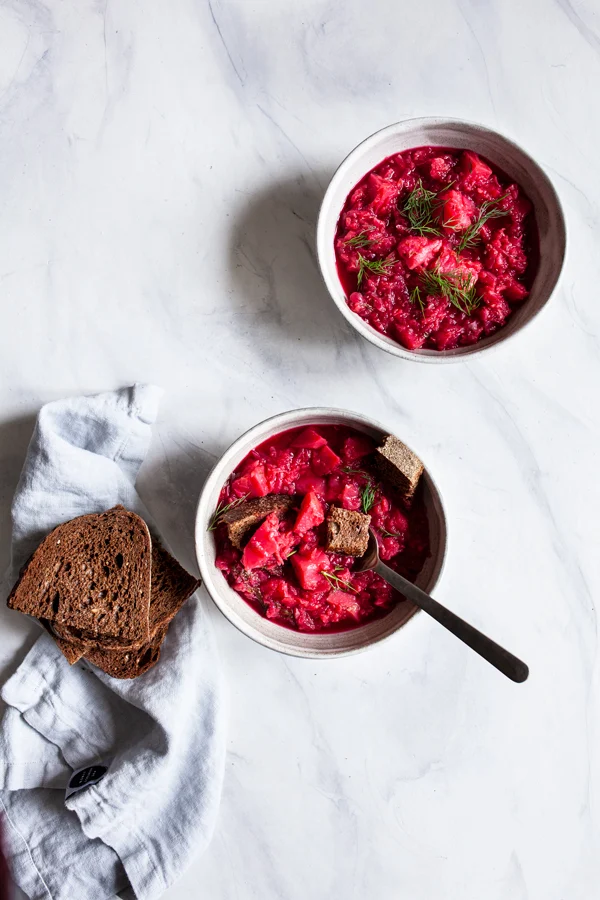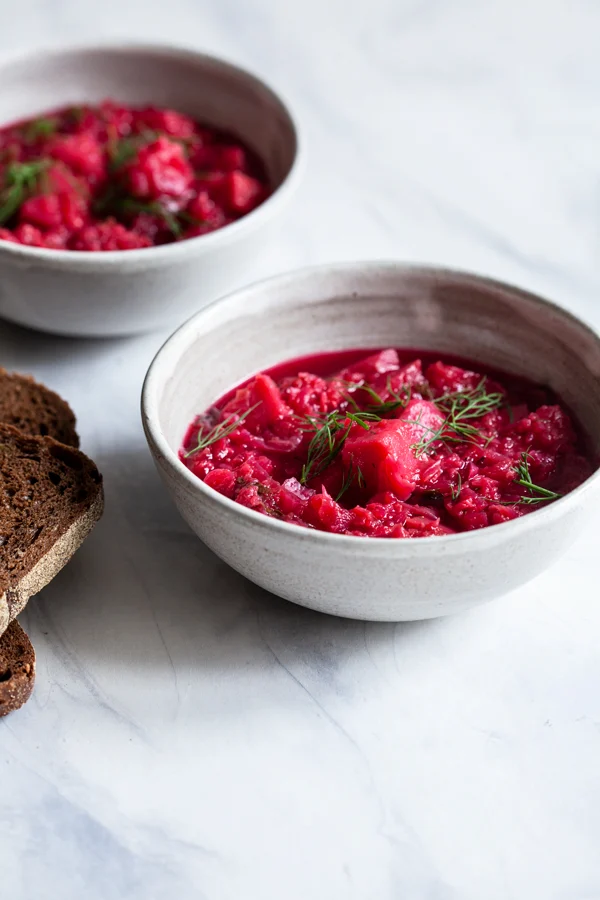
It seemed like an exciting time for me to make borscht, often considered a winter soup, but last Saturday I passed the farmers market filled with beets and cabbage. I picked them up before I knew what to do with them.

There’s a story at the beginning of Anya Kassoff’s beautiful new cookbook, Simply Vitality. The main character is Anya’s grandfather, Aleksei Gerasimovich Golub, a shoemaker born in the North Caucasus before the Russian Revolution of 1917. One of the fables he passed down to his grandchildren is about an early morning long ago when he was hiking through the streets of Blagodatny. Alexei was still suffering from the hangover from the night before, and he felt uncomfortable in the rising summer sun.
Alexei visited an acquaintance who lived on his way to work, secretly hoping that the hospitable friend would give him a glass of cold milk. His friend Peter Vasilevich did just that. Alexei refused once, following a custom in which it was polite for a guest to decline to be offered food or drink initially, and then the host would insist. Peter insisted on following the custom, but Alexei, overwhelmed by what Anya called “a stubborn Slavic courtesy,” refused again. He looked forward to another job, but it never came. So he was back in the hot weather, feeling thirsty and unsatisfied.
Anya claims that her grandfather told the story so often that she suspects something about it haunted him, even though he found it humorous. She wrote,
“What I took away from my grandfather’s story is that opportunities exist; opportunities don’t come along every day, so it makes sense to hold on to them. I often think about the moral of this missed opportunity and use it as a guiding force in my own life. It helps me see the big picture, and I often ask myself whether I take or give up my glass of milk. Regarding my career, which now involves cooking, coming up with recipes, and dreaming up foods, I’ve found a straightforward way to live out the moral of my grandfather’s story: Cook with the seasons.”
This was my euphemistic way of saying that even though Anya listed borscht as a winter recipe (one of the nice things about her new recipe is that the recipes are labeled by season), I felt like I had met her invitation and jumped at the chance to make this beautifully colored, delicious soup with my beets and cabbage.

I didn’t review Anya’s first cookbook, The Vibrant Table, on my blog. However, it’s one of the most creative plant-based cookbooks I’ve come across, and her blog, Golubka Kitchen, is my favorite. Anya’s recipes are always fun and nutritious, but what I love most about them is their color. They are always pleasing to the eye: fresh, bright, vibrant.
Simple Vitality is a tribute to seasonal cooking. However, it also shares some qualities I love about Anya’s other books: thoughtful recipes, an emphasis on natural foods and cooking from scratch, and a sense of connection to tradition. Anya often inserts stories about her family and roots into her notes. She offers many recipes inspired by traditional Russian cuisine.
Reading her blogs and books, I feel transported to a kitchen where food has been prepared with love for generations. As someone with no strong family history of food, being invited to Anya’s home felt like a treat.

Earlier this winter, a friend asked me if I had a recipe for borscht, and I didn’t, so I was happy to accept Anya’s recipe as my first recipe. It’s her mother’s. “My mother came up with a unique vegetarian version of her favorite staple to give us kids lighter, healthier foods,” Anya wrote.
When I first read this recipe, it required a lot of slow cooking and layering, and even though school was out, I wasn’t sure how long it would take. I often use cookbook recipes freely, but I follow Ina Garten’s advice to follow the book recipe strictly or closely to it the first time I make it. That way, I know what it should taste like and what each ingredient and step does.
I’m glad I made this recipe like Anya did instead of taking a shortcut. She notes that her mom’s method is to “gently soak various vegetables in their juices to give this vegetarian borscht an irresistible flavor.” She’s right: not only is it incredibly delicious, but it’s even better if you leave it for a day before eating it. Having those flavors come together makes a big difference.
Anya claims to have a very intuitive cooking method, so while I wanted to stay true to her technique, I added a little trick of my own: a generous sprinkling of red wine vinegar at the end. I like acid, and although the tomato has some acid, it gives the soup a more robust flavor. I serve my dish with old-fashioned rye bread (either on the side or torn into potato chunks). However, I like Anya’s suggestion to add some cream (vegan sour cream, cashew cream, or yogurt are great).
Ingredients
1 large carrot or 2 small carrots
2 medium parsnips
1 medium red beet
1 rhubarb onion
1 Small celery root, optional
Two green peppers
1 Little jalapeno
1 tablespoon coconut oil or olive oil, I’m using olive oil
Sea salt and freshly ground black pepper
1/2 medium head of greens
Peel 4 to 6 Yukon gold potatoes and cut into small cubes
1 28-ounce can of chopped tomatoes
7 garlic cloves chopped
1/4 cup chopped fresh dill, plus more
1/4 cup chopped fresh parsley, plus more to set aside
Optionally, add a little red wine vinegar
4-ingredient vegan sour cream (for serving; Use store-bought sour cream instead.)
Instructions
- Peel carrots, parsnips, beets, Onions, and celery (if desired) and remove the seeds from bell peppers and jalapeno. Chop all vegetables and place them in the feed tube of a food processor with a chopping attachment. Shred all the vegetables and put the mixture into a large, heavy-based stockpot.
- Pour the oil into the pan and season with salt and pepper. Reduce the heat to medium so that the juices run out and start to simmer, then reduce the heat to low, cover the pan, and allow the vegetables to simmer in the juices for 30 minutes until all the juices have escaped and the vegetables are tender.
- Also, replace the food processor attachment with a slicer. Roughly chop the cabbage to fit into the food processor’s feed tube and slice using attachments. Alternatively, use your hands to cut the cabbage into thin slices. Transfer the cabbage to a large bowl and cover it with cold water; stand by.
- After the shredded vegetables have cooked for 30 minutes, place the potatoes on top and pour enough water to cover the potatoes completely. Reduce the heat to medium and bring the liquid to a boil, then reduce the heat to a simmer and cook, partially covered, until the potatoes are tender, about 10 minutes.
- Meanwhile, bring a pot or medium saucepan of water to a boil. Drain the cabbage and place it in the pan with the potatoes and shredded vegetables. Pour boiling water over the cabbage and fill the pan, but leave some room for the tomatoes. Add a few large pinches of salt. Simmer for 15 to 20 minutes, or until the cabbage is tender, then add the crushed tomatoes and bring the soup to a boil over medium heat. Taste the salt and adjust if needed. As soon as the soup boils, remove the pan from the heat and add the garlic and herbs.
- For best results, allow the borscht to come to room temperature, then refrigerate overnight to develop its flavor fully. When you’re ready to serve, reheat the borscht on the stove. Serve with sour cream and more chopped dill and parsley, if desired.

Other recipes in the book are similar to this one in that they may involve a step-by-step process but are not random: if different vegetables are cooked separately, for example, then each vegetable is very tender, rather than overcooked or undercooked. Many remaining recipes are simple, including salads and bowls, base dishes, and vegetables.
The book also includes a chapter on porridge and pancakes (my favorite breakfast!). , rolls and rolls, risotto, paella, pilaf, noodles, pasta and pizza. There are so many things I’m eager to try that I don’t know where to start. However, I’m a fan of Bukhara Farro Filaf(a variation on plov), spelled lasagna made with melted rainbow beets, chickpeas, kale salad rolls, and kale stuffed with couscous in coconut curry sauce. The book isn’t all vegan, but it’s primarily plant-based. Most recipes can be vegan with non-dairy alternatives if they’re not vegan.


